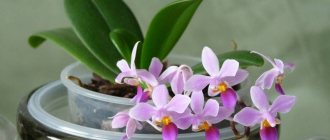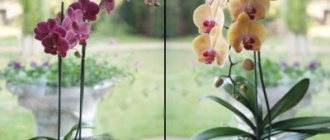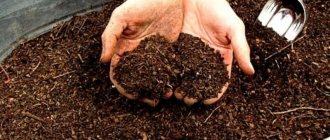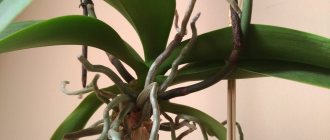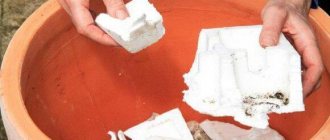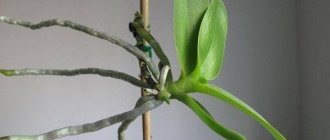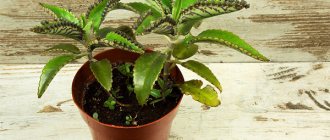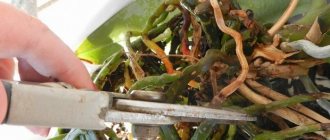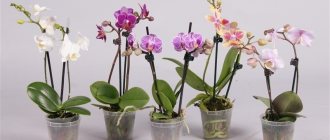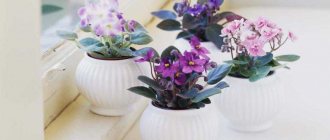Where are they located and what do they look like?
This plant is very common and has more than 30,000 varieties.
Orchid seeds ripen in seed pods that appear on the orchid after the flower is pollinated.
They can only be examined under a microscope, they are so small that they can be mistaken for dust. If you compare an orchid seed with a grain of wheat, to which they are very similar in appearance, then the grain is 15,000 times larger.
Orchid seeds meet the following parameters:
- Small, like dust. One seed measures 0.35-3 mm in length and 0.08 to 0.3 mm in width.
- Color – cream, beige, light brown.
- Narrow, elongated shape.
Many will wonder how plants reproduce in nature with such small and demanding seeds? It's all about the number of seeds - there are more than 5 million of them in one box. The wind carries the seeds, they cling to the bark of trees, but only a few germinate .
We offer a video to see what an orchid box with seeds looks like:
Distinctive features of real ones from fake ones
This is quite simple - the bag should contain creamy “dust”. Some flower lovers order seeds from the Internet to be delivered to their home, and having received seeds of a different type, they vainly hope to grow an exotic beauty from them, but this, unfortunately, is impossible.
Some people, when buying orchid seeds in a store, feel the large seeds and think that they are capsules - this is also not true. It is worth knowing that as soon as the seeds ripen, the capsule cracks and they fall out , so it is impossible to keep it intact.
Peculiarities
The orchid is a flower that has been known for a long time. Many peoples were fascinated by the beauty of the orchid and tried to grow the culture in their homeland. Thanks to its original appearance and variety of petal colors, the orchid still captivates the hearts of many people. In Asian countries, this plant was considered medicinal, which can be learned even from the works of Confucius, but in Europe its aesthetic properties were more valued. When calculating species diversity, a figure was obtained that exceeded 30 thousand varieties.
Orchids originally grew in the wild and were difficult to grow indoors. Only thanks to the painstaking work of scientists it was possible to develop varieties that can be successfully grown at home, and at the same time they delight with flowering for a long time. Experienced gardeners can easily get seeds and grow a new plant, but it will be more difficult for a beginner to cope with this.
The most important factor for good flower growth is light. There should be enough of it - a deficiency adversely affects the general condition of the culture
It is important to make sure that it is diffused; direct sunlight should not fall on the leaves and petals. If you place an orchid on a sunny window without any protection, the leaves will begin to lengthen, and you may not see flowering.
If you darken the glass with tulle or something that allows light to pass through, the rays will be refracted, and the flower will bloom profusely and often.
An orchid can be considered a seasonal indoor plant, because from late autumn until mid-spring the bush rests, concentrating its energy on ripening shoots and laying buds, which will delight with abundant flowering in the new season. To assist in this process, optimal environmental conditions must be created. A comfortable temperature range will be 13-18 degrees Celsius, which should be maintained throughout the cold season.
As spring and warmer temperatures approach, you should gradually increase the temperature in the room or move the flower to a warmer place
In summer, it is also important to monitor how many degrees there are in the room with the orchid. The optimal range will be 25-27 degrees during the day, and 15-18 at night
The next important care criterion is watering. It must be timely, with the required amount of moisture. However, it is better to underwater than to overwater: drought will not destroy the flower, but excess moisture can. It is recommended to carry out the watering procedure using a water divider in the shower. It’s better to organize a water bath for the pot for 10-15 minutes so that the soil is saturated with the required amount of liquid, and then put it on a tray, which will allow excess moisture to drain.
Photo
Look at the photo to see what orchid seeds look like.
Is it available for sale and how much does it cost?
You can find orchid seeds in seed stores, and ordering them online is not difficult.
The cost of planting material depends on several factors:
- varieties;
- manufacturer;
- quality;
- packaging material.
But the average cost of 20 seeds ranges from 180 to 250 rubles.
It is worth mentioning separately about the seeds that can be purchased on Chinese websites; they cost around 50 rubles for 100 pieces. But despite the cheapness, it is worth understanding the risks, since it is almost impossible to obtain high-quality material. But nevertheless, there are sites that sell good planting material from which it is possible to grow magnificent flowers. Read more about how to grow a beautiful flower from seeds from China at home in this material.
Choosing seeds
Let's start with the choice of seed. Several types of these plants are suitable for the home indoor “climate,” but the phalaenopsis orchid varieties are the most common and are well adapted to our natural conditions. Gardeners also choose the seeds of vanda, cymbidium, zygopatelum, and dendrobium.
To choose high-quality material on the Internet, you can focus on the degree of recognition and scale of the manufacturing company. This, of course, is not a 100% indicator, but large enterprises are less likely to risk selling counterfeits. The best option is to consult with other gardeners who will suggest reliable companies. Flower gardeners often purchase orchid seeds in China through special websites. This method is more reliable and less expensive.
How to get it at home?
Orchid seeds can be obtained at home , for this you need to cross-pollinate during flowering.
Take a soft brush and transfer pollen from one inflorescence to another.- As soon as the plant fades, boxes will appear in which the seeds will ripen.
- After three months, the box is wrapped in a paper napkin in order not to lose the seed material when the testis cracks.
- The capsule will definitely crack as soon as the seeds ripen.
- After this, the testis is cut off and the seeds are poured from a napkin onto a clean sheet of paper.
- Divide the seed material into parts.
- Wrap each part in a separate white piece of paper, place it in a plastic container and put it in the refrigerator until you plant it.
We invite you to watch a visual video of orchid pollination at home:
Secrets of artificial pollination: expert advice
How to properly plant peas in open ground with seeds
To increase the chances of pollination and get good seeds, you should take into account several important nuances:
“If the air humidity in the apartment is insufficient, it is better to take young flowers for pollination. In older ones, the top of the column dries out, and the fertility of the organ decreases. In general, orchids that are used for seed propagation must be kept in an ideal microclimate. Everything can play a role here - humidity, air temperature, and light intensity. If it is not possible to create the necessary conditions in winter, it is better to postpone pollination until spring or summer.”
E. Ladychuk, orchid collector, biologist
Advantages and disadvantages
There are aspects that can be attributed to the disadvantages of growing orchids from seeds:
- labor intensity and complexity of the process;
- requirements of planting material for sterility and nutrient mixture;
- duration;
- the risk of purchasing low-quality planting material.
But, despite this, you can also find certain advantages in this process - this is the pleasure that can be obtained from observing the process of seed germination. And when these small seeds grow into beautiful, flowering plants, all the disadvantages will turn into advantages. But it is worth remembering that you will get a flowering plant only after 5 years .
Cultivation instructions
As mentioned above, before sowing the seeds, you need to prepare everything you need.
Equipment and its sterilization
In the store you should buy:
glassware - these can be test tubes, glass flasks or 100 gram jars with lids that will be hermetically sealed;- cotton wool and a sterile bandage or gauze; stoppers for test tubes will need to be made from this material;
- a rack for test tubes, if germination will be carried out in them;
- litmus paper to determine the acidity of the nutrient mixture;
- hydrogen peroxide 2%;
- a special pipette or sterile syringe.
If you choose ordinary glass jars for germination, then you need to make holes in the lids for glass tubes, since the seeds need air. As soon as the seeds are placed in the mixture, the tubes will need to be closed with stoppers made of gauze and cotton wool.
Sterilization:
- The dishes are sterilized together with the prepared composition - this can be done in a double boiler, oven or in an electric oven by placing the dishes in a water bath.
- You need to sterilize in an upright position, with the lids tightly closed.
- If we talk about time, then together with heating the oven or steamer, this process will take about an hour.
- Sterilization temperature 120 degrees.
- After sterilization, cool the composition to room temperature.
Preparation of seed material
As already written above, the seed pods are wrapped in a napkin, and as soon as the testis bursts, the seeds are ready for sowing . In our case, they are already in the refrigerator; they can simply be taken out of the container.
Nutrient medium for planting
It’s worth warning right away that the process is labor-intensive and requires care and attention. You can, of course, buy a ready-made mixture in the store, but if you want to go the whole way of growing an orchid from seeds yourself, then prepare a nutritious mixture at home.
Will need:
1 liter of distilled water;- agar-agar – 8 g;
- glucose – 10 g;
- complex phosphorus-nitrogen-potassium fertilizer – 1.5 g;
- fructose – 10 g;
- stimulator forming the root system – 5 drops;
- activated carbon – 1 g.
Procedure:
- Pour 0.5 liters of water into a container, put on fire, and boil. While boiling, add agar-agar, glucose and fructose. Reduce the heat and cook the mixture until the agar-agar is completely dissolved.
- Heat the second part of the water, add fertilizer, coal, phytostimulant to it and mix well.
- Combine both compositions and check the acidity.
- The acidity of the nutrient mixture should be from 4.8 to 5.2 pH - this is the most favorable environment for the germination of orchid seeds. It can be increased with orthophosphoric acid, and decreased with potash solution.
The nutritional composition should not be too thin or thick; ideally, the germination mixture is a jelly .
Pour 30 mg of the mixture into each 100 g jar, seal tightly and sterilize. Now it’s worth checking the composition for sterility - to do this, leave the jars at room temperature. If during this time a pathological environment has not developed in the composition, then it can be used; if mold has appeared, then we throw everything away and start all over again.
Below is a visual video on how to prepare a growing medium for planting orchid seeds:
Preparatory stage
Before putting the jars with the solution for sterilization, you need to wrap the lids with foil , since the lids can be torn off during the heating process.
How to plant and germinate correctly?
Before planting a flower at home, its seeds and nutritional composition must be thoroughly sterilized. To do this, you need to prepare a 10% chlorine salt solution.
- Pour 10 g of chlorine into a liter of water and stir until completely dissolved.
- Filter the mixture through several layers of cheesecloth and place the seeds in it for 10 minutes.
- The seeds are pulled out with a sterile syringe and placed into the nutrient mixture through tubes, which are immediately closed with a cotton plug. You can place flasks for seed germination, the air temperature should be 18-23 degrees, and the daylight hours should be 14 hours.
Below is a visual video of planting orchid seeds:
Read more about how to plant an orchid here.
Seedling care
After about a month, pseudobulbs will begin to appear. In six months, the flasks will contain green seedlings with roots, but the seedlings can only be replanted after a year.
Read more about growing orchids in a flask in this material.
The orchid is transplanted into a substrate that consists of sphagnum moss, fern roots and pine bark.
The transplant is carried out in the following way:
- the substrate is placed in boiling water for 30 minutes;
- open the jars, pour a little boiled water into them;
- then pour the seedlings into a container with a foundation solution;
- take tweezers with rubber tips and transfer the seedlings to the substrate, do not deepen them;
- provide greenhouse conditions;
- It is worth spraying seedlings every day from a distance of 20 cm.
We invite you to watch a visual video about caring for orchid seedlings and replanting them:
We invite you to familiarize yourself with information about soil and pots for orchids, about choosing a Thai orchid and about growing a flower from Vietnam, also about how to grow using hydroponics or in a closed system, and about planting with children.
Problems and difficulties
There can be many difficulties when germinating seeds yourself:
- It is almost impossible to obtain seeds from an orchid at home.
- It is not always possible to buy high-quality planting material.
- At any stage, death of seeds or seedlings may occur, since sterility for cultivation must be absolute.
At home, unfortunately, it is difficult to properly grow orchids using seeds, so think before you decide on this not very simple process. There are more affordable ways to propagate this exotic plant. But if you do everything according to the rules and be patient, a positive result will not be long in coming.
Varieties of orchid seeds
The variety of orchids is impressive and has hundreds of varieties, but only some varieties of this wonderful flower can grow in open ground. The reason for this was the place of growth, that is, a tropical area. The strongest in this regard are considered to be Dutch orchids, which adapt well to new conditions and are suitable for our climate. We have also found many successful ways to collect orchid seeds and grow full-fledged plants from them. It is quite difficult to do such work at home, as it requires experience, money and patience.
Orchids Cymbidium
The bulb of the Cymbidium variety is ovoid in shape, the leaves of the flower are linear, xiphoid, keeled and leathery. The orchid peduncle is quite tall and can reach up to 1.5 meters in height. The inflorescence is in the form of a large hanging raceme, on which a different number of flowers may be present, taking into account the condition of the bush and its care. The sizes of flowers can also be different, based on the type of flower, from the smallest to the largest buds. The colors of flowers vary: they are yellow, green, cream, red, brown, pink and any shades of these colors. The three-lobed lip of the flower has bright, variegated colors. Flowering averages 2-3 months, average lifespan is 3-7 years.
For planting, you will need special soil for orchid seeds, which is sold in specialized stores. The most suitable nutrient medium for Cymbidium orchid seeds is a mixture of fern roots, pine bark and live moss. It is prohibited to use soil for planting, as the roots of the plant will simply rot; this is observed due to the lack of the required amount of oxygen in the soil. As a result of lack of air, the soil becomes waterlogged and pathogenic bacteria multiply. But if special soil is used, then it ensures the supply of atmospheric air by 75%, which is very important for the roots.
It is very difficult to collect Cymbidium orchid seeds, since this requires laboratory conditions, so propagation is carried out by dividing the bush. This is usually done during transplantation, when the young bulbs are separated from the mother bush. In most cases, the largest young bulbs already have their own roots, so they tolerate transplantation well. After division, the mother bush practically does not get sick and continues to grow as before, if everything was done correctly.
Vanda orchids
The Vanda orchid is a fairly large orchid, which has several dozen subspecies. Considering the variety, the size of the flower and the peduncle itself may vary, as there are miniature dwarf forms that are distinguished by bright colors and original combinations of shades. Regarding whether there are Vanda orchid seeds, they are not available, but they are obtained in the laboratory, using them to breed new varieties. Reproduction of the Vanda orchid occurs by buds or rosettes, which are on peduncles or stems. After the children have developed their own roots, they are transplanted into a separate container.
To get the babies of this orchid, you need to perform certain manipulations. To begin, carefully cut off the peduncle and dry it a little, lubricate the lower part with cytokinin paste, slightly pushing back the thin film. Next, the cut peduncle should be placed in a plastic bottle with water and placed on the windowsill. Within a month, young, fairly developed buds will appear on it, and then children with small roots will grow from them. You can also use the second method of propagation; for this, the peduncle is divided into parts, each containing three buds. These parts are placed in a moistened substrate and then covered with a plastic bottle. The result is a greenhouse effect, where there is sufficient temperature and high humidity. Place it on the window so that the sun hits the seedlings a little.
White Heron Orchid
Many breeders do not consider the White Heron orchid to be a member of the orchid family. According to external features, it is a perennial, deciduous, terrestrial plant with a small height of 20 cm. Orchid tubers can be eaten, so in Japan and Asian countries they are often used for making soups and stored for the winter. In regions with a warm climate, the flower tubers are left for the winter, covered with leaves or sawdust. You need to know that it is almost impossible to grow the White Heron Orchid from seeds, since it reproduces by tubers. It is also very difficult to care for; it requires a properly selected pot and soil with the required acidity. You can purchase such soil only in specialized stores. Drainage is always placed at the bottom of the pot, and the tubers are placed in the pot to a depth of about 6 cm. The flower does not tolerate drying out of the soil very well, which can lead to the death of the entire plant. To maintain moisture, the top of the soil is covered with moss. The variety blooms in August-September.
Black Orchid
There are several types of black orchid that belong to a specific group, each of them differs in external characteristics, but the care for all is almost the same. It is possible to collect black orchid seeds, but this will require certain manipulations and almost laboratory conditions. For example, the black orchid species Maxillaria schunkeana produces the darkest flowers of any variety and is considered very rare. Therefore, many breeders do not even know what the seeds of this variety of phalaenopsis orchid look like.
The Fredclarkeara After Dark variety is a unique flower that has a slightly bluish tint. The Phalaenopsis Black Butterfly “Orchids” variety is distinguished by an interesting structure of petals, which are shaped like butterfly wings. Orchid flowers are dark burgundy and very beautiful. The variety Paphiopedilum Pisgah Midnight can also be classified as a black orchid. Regardless of the variety, each plant needs tree bark and a spacious pot, which will help bring it closer to its usual habitat, that is, to the tropical jungle.
